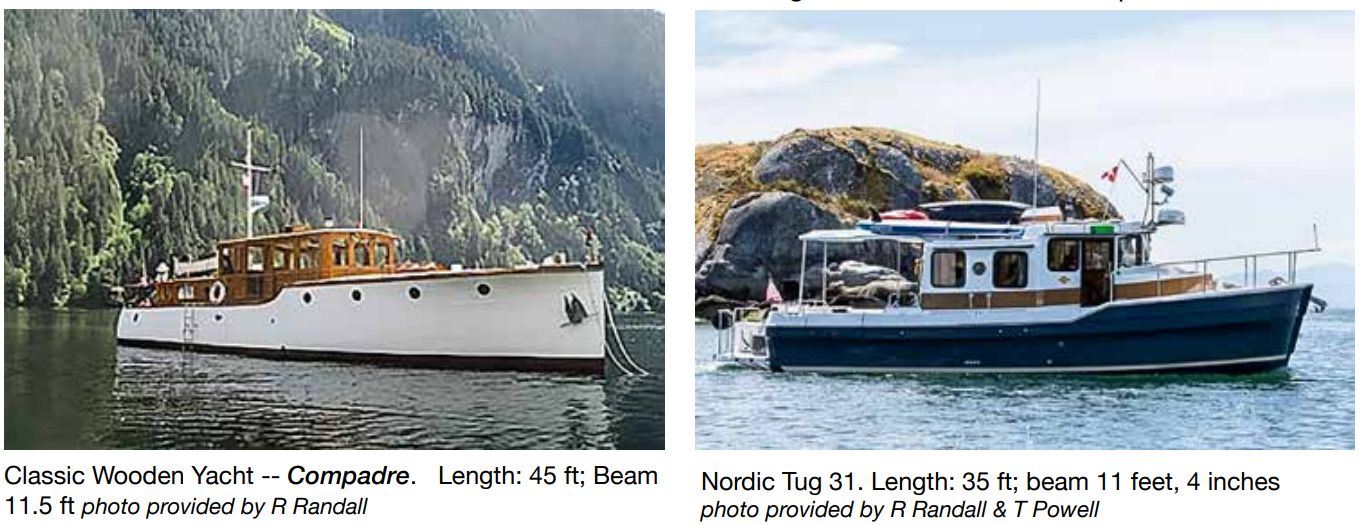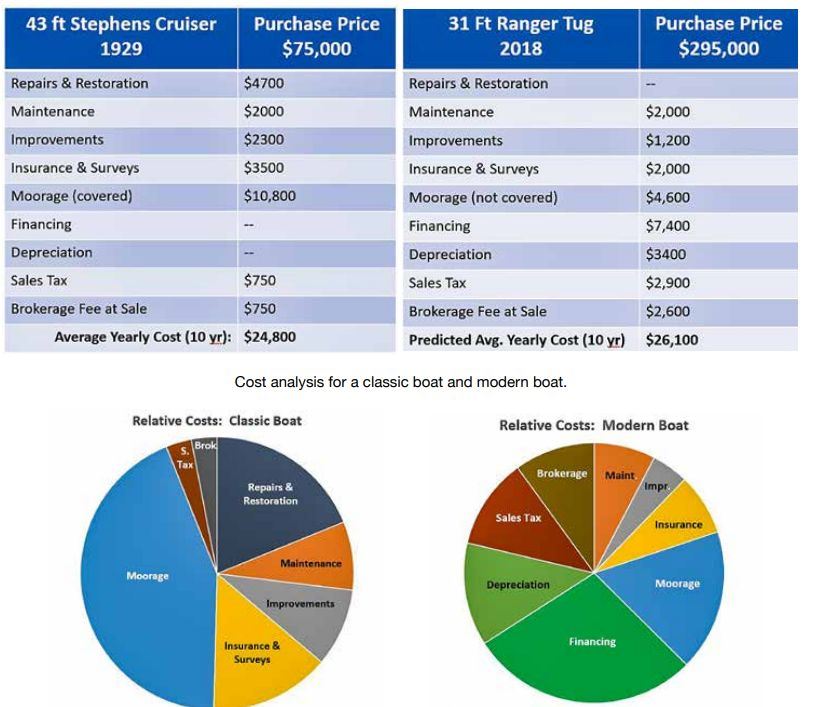The Real Cost of Ownership: Classic vs Modern
Richard Randall and Todd Powell, Pacific Northwest Fleet
[Excerpt from CYA Classic Yachting, Summer 2022]
It is often assumed that owning a Classic wooden boat is unreasonably expensive, and that assumption is frequently the topic of conversation with non-wooden boat owners. We heard it so often that we decided to take a hard look at the numbers. Just how much more expensive is owning a classic wooden boat than owning a nearly new fiberglass boat?
The answer to that question depends on the size and condition of the classic boat being considered and the modern boat you choose for comparison. Surprisingly, we found that owning a classic boat in the range of 35- to 45-ft is probably no more expensive than owning a modern fiberglass boat of similar size, and in some cases may be less.
When comparing classic and modern boats, we must first consider a few facts:
- The purchase price of wooden boats, including classics, is low compared to new or nearly new fiberglass boats. Good classics, ranging from 35-45 ft length overall, often sell for between $50,000 and $100,000. That price range has changed little over the last 20 years.
- Well-maintained classic boats don’t depreciate. In most cases, depreciation ended in the distant past. (It’s important to note that they don’t appreciate much either.)
- Because the purchase price is relatively low, classics commonly are purchased with cash, in which case there are no financing charges. The purchase price of many classics is about the same as the cash down-payment required on new or nearly new boats.
For our analysis we compare two boats: The 1929 43-ft Stephens cruiser Compadre, and a 5-year old Ranger Tug 31 we found on the internet. Ranger Tugs are popular cruisers here in the Pacific Northwest; many people obviously can afford them. We chose not to consider a brand-new boat, reasoning that many purchasers would prefer a slightly used boat because someone else had already outfitted it and experienced some depreciation. We compared the annual cost of ownership for both boats averaged over 10 years, and assumed that both boats would be sold at the end of that period, incurring standard brokerage fees of 10% of the sale price. We estimated moorage-costs based on current rates at a large Puget Sound marina, assuming a 50-ft covered slip for Compadre and a 36-ft open slip for the Ranger Tug. Of course, costs will be different in other areas.
 Note that we have not included effects of inflation in our analysis, since that adds a greater level of complexity and we are not accountants; however, we believe the end results will not be changed significantly. But is it fair to compare a 43-ft classic with a smaller fiberglass boat? Why not choose a modern boat about the same length? Partly because modern boats are much wider for their length than classics, and thus have proportionally larger interior volume, often with more amenities. It is interesting to consider that choosing a larger fiberglass boat would have skewed the outcome even more in the classic’s favor owing to higher financing, tax, and moorage costs for a larger boat.
Note that we have not included effects of inflation in our analysis, since that adds a greater level of complexity and we are not accountants; however, we believe the end results will not be changed significantly. But is it fair to compare a 43-ft classic with a smaller fiberglass boat? Why not choose a modern boat about the same length? Partly because modern boats are much wider for their length than classics, and thus have proportionally larger interior volume, often with more amenities. It is interesting to consider that choosing a larger fiberglass boat would have skewed the outcome even more in the classic’s favor owing to higher financing, tax, and moorage costs for a larger boat.
First we consider Compadre. She is a 43-ft Stephens Brothers cruiser, currently in excellent condition, and is owned by one of the authors. The purchase price was $75,000 in 2007. She was in good condition when purchased; nevertheless, she has since undergone repairs that are typical of a boat of her age, including 20 pairs of sistered frames, new floor timbers and keel bolts. Some interior cabinetry that was removed by a former owner was restored.
The actual costs of ownership, averaged over the 10- year period from 2007 to 2017, are shown in the tables following.
Now consider the modern boat. Our example is a 2018 model currently offered for $295,000, which we assumed as the purchase price.
We assumed the boat would be financed as follows: Down payment $75,000 (the purchase price of Compadre); loan amount $220,000; annual interest rate 4.12%; loan term 20 years (rate current at time of writing). We also assumed there would be no repair costs for this modern boat during the 10-year ownership period.
It is important to note that our cost predictions are based on information from the internet and other public sources, along with our experience as longtime boat owners. We have no first-hand knowledge about Ranger Tugs; we are simply using this one as an example, and our cost numbers undoubtedly would be different with other boat makes and models.
While the tables show that the long-term cost of owning these boats would be roughly the same, the costs are concentrated in different areas as illustrated by the pie-charts following.
For the classic boat, covered moorage is the largest single cost of ownership, followed by repairs/restoration and insurance.
For the Ranger Tug, financing is the largest cost, followed by moorage, depreciation and sales taxes. Depreciation for boats is hard to estimate, but after some online research we used what we believe is a modest 1.5% annual rate. In conclusion it appears that the costs of owning a typical 43-ft classic cruiser and a nearly new fiberglass boat are about the same; however, the expenses are centered in different areas. This suggests that many owners of modern boats could easily be owners of classic vessels if the choice were strictly financial. So why aren’t they?

